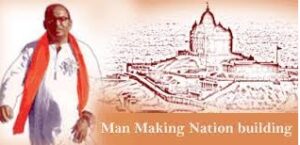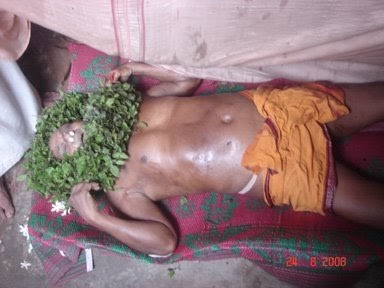
“ He was a Man with Capital ‘M’”
“ He was a bridge between the North East and the rest of India”
“ His life was that of a Karmayogi;” – Organiser, magazine
“ If I have two or three persons like him, I will revamp the Congress and there by the nation.” Lal Bahadur Sastri, then Union Home Minister and later Prime Minister.
“ .. with sheer dint of his industriousness, determination, courage, intellect, strength and all inclusive attitude became the best role model for the countrymen to emulate and follow” – RSS Sangachalak Parampoojaneeya Mohan Bhagwatji
“ He united the nation, leaders across the party lines for a cause, united the past with the future.. Generally, we hear people wishing their juniors to be successful.. he went one step ahead and used to wish be successful and also meaningful. He was a role model for me” – PM Narendra Modi on this legendary personality at the inaugural function of the Centenary Celebrations. (Nov 9, 2014)
Whom are we referring?
The monument erected by him, the institution founded by him, the brothers and sisters trained by him, the memories they carry about him continue to speak volumes about this great son of Bharata Mata. The monument and the institution he caused to be created are world famous, however the individual who made it possible is less known. Though he was a towering personality, he buried himself as the foundation for a great temple to be built to serve the national cause for centuries to come.
Yes, we are referring to none other than Amarajeevi Ekanath Ramakrishna Ranade ji. He was the moving spirit behind Swami Vivekananda Rock Memorial, Kanyakumari which is standing majestically at the southern tip of the Bharat.
Life in nutshell
Eknath was the youngest of eight siblings (four brothers and four sisters). He was born on 19 November, 1914, at Timtala in Amaravati District of Maharashtra to Shri Ramakrishnarao Vinayak Ranade and Ramabai. Since the family moved to Nagpur, he had schooling in New English School in that city and later he did Master in Philosophy. Further he graduated in Law too.
Since he lived in Nagpur from 1920, during his school days itself he started attending RSS shaka (branch) and he came into direct contact with Sangha founder Dr. K B Hedgewar ji. Every week end during his school days itself, he and his friends used to go by bicycle to suburban towns like Kamptee to start new shakas in those places. ( Late Shankara Sastriji who was a Swayamsevak in one of those shakas was inspired by Eknathji and became pracharak and came to Chennai in 50s. A senior Swayamsevak told this writer that Shankar Sastriji whenever he talks about Eknathji used to become ecstatic and choked with emotion).
Immediately after completing Law, he became Sanga pracharak and worked in various capacities in various towns and States. Of them, the role played by him in central provinces and Eastern provinces from Odisha to Assam were noteworthy. During the nearly two years of ban of RSS, in the aftermath of the assassination of Mahatma Gandhi, then Sarchangalak- head of the organisation Paramapoojaneeya Madhava Sadashiva Golwalkar ji (fondly called Guruji) courted arrest. At that time Eknathji went incognito and co-ordinated the peaceful resistance- Satyagraha. He was the force on the field to steer the movement in the midst of thunderstorms that is hostile government and unsympathetic civil society. He approached senior advocate T R Venkatarama Sastri and Sardar Vallabhai Patel, then Union Home Minister. His knowledge in law came to aid. He was instrumental in drafting- redrafting the constitution for the RSS organisation and with Patel’s approval the ban was lifted. After 1950, he was back in the field and doubly active to pick up the momentum and revive the organization to gain further expansion. Gradually, he became national Prachar Pramukh and went on to become Asstistant General Secretary (Saha Sarkaryavah). At that time, the God sent Mission came in to his life, which possessed him till his last breath.
One Life One Mission
In 1962, Swami Vivekananda’s birth centenary preparations were happening in many cities. For Eknathji, Swamiji’s teachings were the source of inspiration and his conviction was that RSS is the organization which has come to carry out the vision and to fulfil the aspirations of Swamiji. He poured over the complete works of Swami Vivekananda, extracted an essence of his speeches and made a book weaving around the common theme that Hindu society should shed its tamasic behaviour. ‘Wake up out of Slumber , develop leadership qualities to be of service to the nation and to whole world for which let the country be filled with rajasic wave’ was Swamiji’s thundering message which propelled the independence movement. Hence, Eknathji aptly titled the book as ‘ Rousing Call to Hindu Nation ‘. (it has been translated in many major Bharatiya languages and in Tamil by Rama Gopalanji titled ‘ Ezhumin Vizhimin’ )
At that time, an idea to create a monument in Kanyakumari in a rock where Swamiji had mediated for two days (estimated to be between December 25th to 27th, 1892). This is the rock where Swamiji later spoke about as the place where waves of ideas were rocking in his mind- then miserable state of the nation, its past glory, the causes and remedies to get out et al and from here when he rose up after meditation Swamiji had firmed up his decision to participate in World Religious Congress to be held at Chicago in September 1893. As he travelled further up through Tamil Nadu a road map emerged gradually and the rest is history. Hence, no wonder that the suggestion to put up a monument came from Tamil Nadu unit and equally from Haindavi Sangam, Kerala sister organization of RSS. When it was discussed at central level in the RSS, it was decided to take it up as a nation wide project and Eknathji was chosen as the apt person.
Karma Yogi and Sthitapragna
The moment he was entrusted with the task, he swung into action. The ground situation was not very favourable. In Kanyakumari, where the monument had to be put up, some of the fishermen group ‘suddenly discovered ‘ it was St. Thomas’s rock which had been for centuries revered as ‘Sri Pada Shila ‘ ( the rock where Mother Kanyakumari stood up and did penance) which only made Swamiji to reach that rock to meditate. It was managed at local and State level deftly.
At national level, Jawaharlal Nehru was the Prime Minister. The State Government of Madras also had developed cold feet. The idea of monument was initially rejected by the Minister of Education and Culture Humayun Kabir. As advised by Lal Bahadur Shastri, Ranade obtained the signature from over 300 members of the Indian Parliament supporting the proposal in the petition seeking permission. In the meanwhile, Nehru passed away and Shastri, the next PM also passed away in a short duration. Finally, it got the approval from the subsequent Prime Minister Indira Gandhi. Ranade also managed to win endorsement for the project from a diverse section of the political and spiritual community, including sections traditionally not also favourably disposed to RSS. For example, he reached to C N Annadurai, then member of Rajya Sabha through V R Nedunchezian (VRN) and with his concurrence roped in VRN as part of State level committee. (Ref: Dravida Mayai Part II by Subbu, author and senior journalist)
Man with Capital M
He was mobiliser of resources- money, men and material to fulfil the task. As an excellent team leader, he readily accepted the suggestion that came up from swayamsevaks of Karnataka that every citizen should have sense of participation in the memorial that is being built and accordingly One rupee Picture Card with proposed Statue and the building that is coming up was sold whoever donated a minimum of Rupee One. People contributed eagerly Thus the movement spread far and wide and every nook corner.
Further, he persuaded every State Chief Minister and all Party leaders (with the lone exception of EMS Nambothripad) to contribute a minimum of Rs. 1 lakh to communicate to the world that in this project entire nation participated. We have seen in many temples or memorials, people of that denomination or sect or at the most of a particular religion may join hands. In that respect, in the post-independence era, Vivekananda Rock Memorial stands tall as a unique one.
Finally, Rock Memorial was dedicated to the nation on Sep 02, 1970 by the then PM, Smt. Indira Gandhi.
A Living Monument
When the Rock Memorial project was completed, Eknathji did not wish to stop it with just the maintenance and upkeep of the brick and mortar structure. He believed that a fitting tribute to be Swamiji will be a living institution organising people charged with the missionary spirit to serve the downtrodden and deserving people living in high mountains and far flung forests. Therefore, he reorganised Vivekananda Rock Memorial Committee into Vivekananda Kendra which is recruiting young educated brother and sister Sevarthis who are volunteering to serve Kendra’s projects providing quality education and medical services at low cost for the past nearly 5 decades. These Sevarthis’ dedication is to be seen to be believed. You can spot many sisters and brothers of Kerala, Tamil Nadu and Karnataka serving in North East and Andamans who do not avail any leave nor visiting their home towns even during annual vacation of the schools. They spend this time also to take the movement further to the new and interior villages and towns.
Lead by Example
From 1962 to 1970, several tumultuous changes had occurred in our country. Just then, we were coming out of the disastrous effects of Chinese aggression. As said earlier, nation had lost two Prime Minster. Once again war with Pakistan was won in 1965 which also had cost the nation dearly. Also we had three successive years of crop failure and famine like conditions prevailed in many parts of the country. Around 1970, the Pakistan instigated atrocities against East Bengal people, Muslims as well as Hindus, was also brewing up which eventually led to full-fledged Bangladesh Liberation War.
As a trained and disciplined senior karyakartha (worker) of RSS which always carries on with mission of service constantly and consistently, unaffected by favourable or unfavourable external conditions, Eknathji lived by the Sangha’s maxim of Sangh ka Karya Paristiti Nirapakshit hai. He used to say often to his fellow workers that in a divine work nothing is impossible.
An ex- Pracharak who had the privilege of serving the Rock Memorial Committee during late 1960s under the direct guidance of Eknathji recalled his yet another phenomenal quality. When Rock Memorial was under construction, every year twice, he used to write letters to MPs the half-yearly status and progress of the project apart from the mandatory reports to government officials concerned. Thus he demonstrated his commitment and remaining accountable to every pie received from the public. Also it taught to his juniors that due respect must be paid to the elected members even if we may not buy their political ideology.
A mahapurush who led a life as a Sadhana of Service came to an end on August 22, 1982 and he was cremated at Vivekanandapuram, Kanyakumari with chanting of Om as the sunset and at Memorial flag was brought down.

